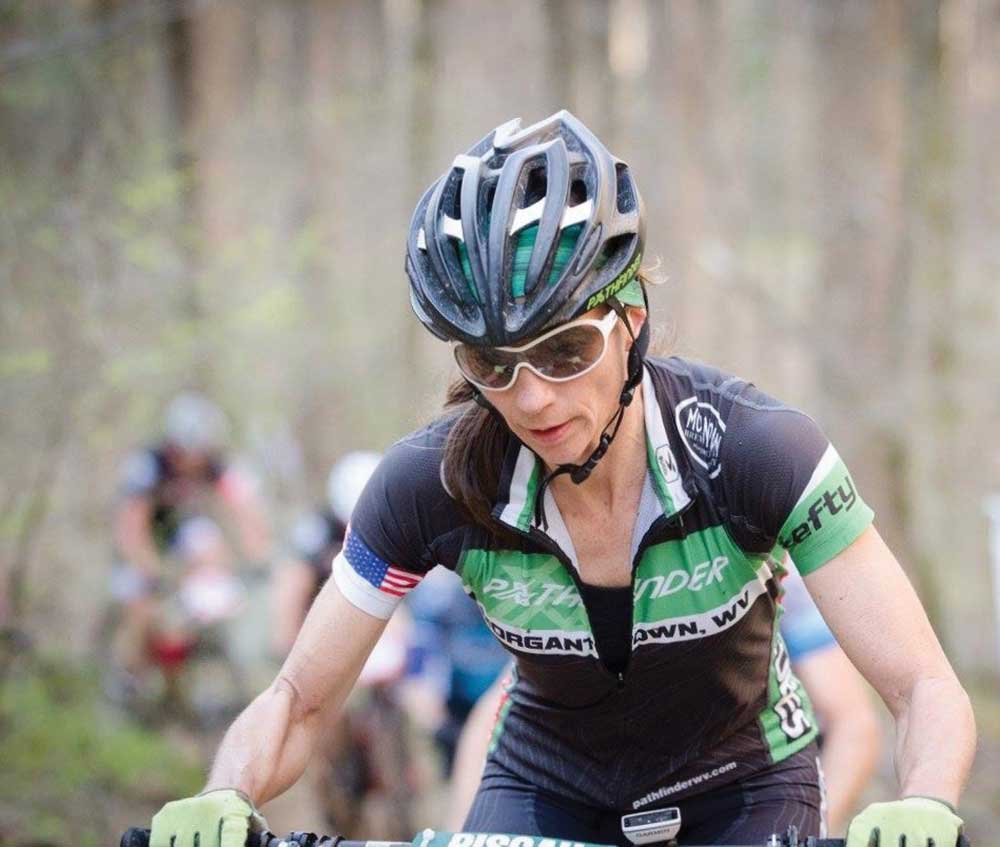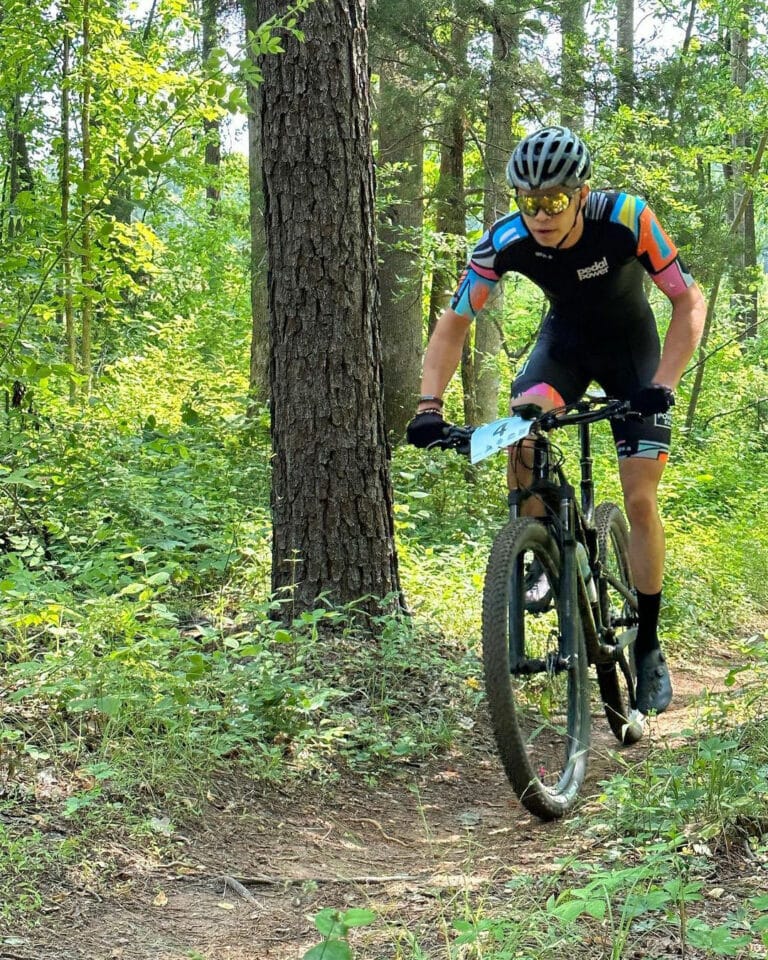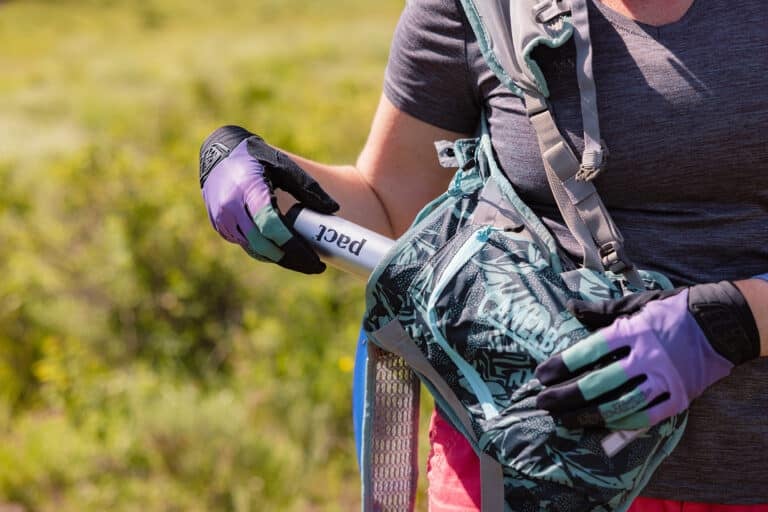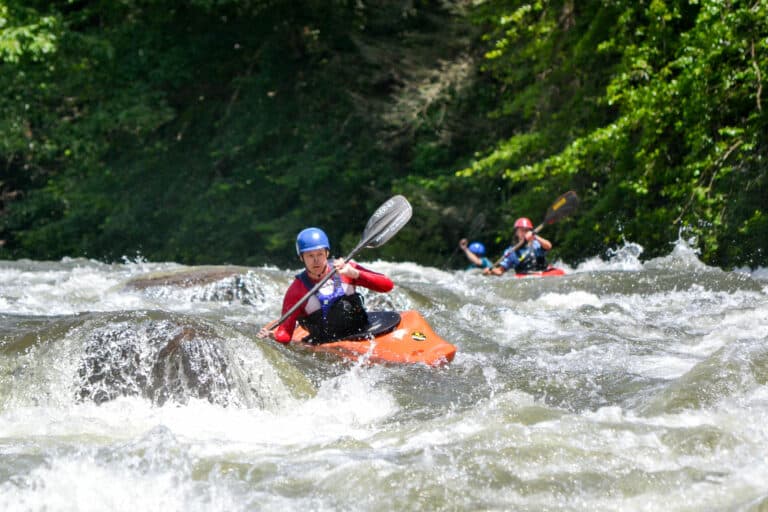Youth bikers and West Virginia state parks partner to construct new trails.
A cluster of teenage mountain bikers slalom through sparse oaks along the final wooded corridor of the new Defend the Bend interscholastic racing trail in West Virginia’s North Bend State Park. With primo rigs and color-coordinated helmets, racing jerseys, pants, gloves, and shoes, the kids look like miniature pros. Seconds later, they burst into a grassy field, pedaling ferociously through blue-taped racing lanes toward a big blow-up marker and crowded gallery lining the finish.
“Great work. Way to push through to the end!” calls Cassie Smith from a nearby tent, pumping her fist at the passing riders. By the end of the day, the West Virginia Interscholastic Cycling League director has congratulated more than 130 middle and high school aged competitors from nine teams—and nearly lost her voice.
Held last Oct. 12-13, the event was the third of the league’s inaugural fall racing series. Despite blustery conditions, about 50 registered coaches and 100 spectators attended. With squads hailing from throughout the state, many families chose to camp, rent cabins, or stay in the park’s 29-room lodge.
“The turnout was amazing,” says North Bend superintendent Steve Jones. A supporter of the league since its formation in 2016, he was instrumental in establishing the 3-mile loop and provided park support for the competition. “The production value was top-notch; everything looked incredibly professional,” he says. “You could tell parents were impressed and, more importantly, that the kids were having a lot of fun.”
Jones had a vested interest in the outcome: The race launched a groundbreaking partnership between the National Interscholastic Cycling League and West Virginia’s Department of Natural Resources. Spearheaded by Smith and Jones, the collaboration hopes to install an estimated 100 miles of sustainably built, NICA-sanctioned racing trails in 10-12 state parks within the next 5-10 years. North Bend was an unofficial pilot. Its success has led to new projects at Canaan Valley Resort and Stonewall Jackson. Smith expects riders will be competing in “at least five state parks by 2023.”
“Steve has really pushed this. His vision and tireless support have been crucial in sparking discussions with other parks,” says Smith. Jones proved that, coupled with targeted outreach, investing in modern mountain biking trails can connect parks with readymade communities of riders. Partnering with interscholastic squads, they become valuable resources for young enthusiasts and their supporters. “This is the definition of a win-win situation,” says Smith.
Bike teams gain access to practice facilities replete with premium machine-built trails. Coaches work with park staffers to help with trail maintenance and fulfill NICA’s requirements for stewardship education. Meanwhile, kids are being introduced to some of the most pristine natural areas in the state.
“I can’t think of a better example of a partnership that fulfills our mission statement the way this one does,” says Jones. “In an age where it’s harder and harder to stay pertinent—and particularly with young people—we’ve found an exciting new way to connect with, and serve, our local and state communities.”
Jones and other superintendents see trails as gateways to discovery: They offer young people a chance to experience the bounty of state parks firsthand.
Jones was introduced to both Smith and NICA at a 2016 townhall gathering held in Morgantown to discuss the viability of an interscholastic mountain biking league. Smith had heard about Virginia’s program earlier that year. Intrigued, she’d attended its year-end summit. What she found blew her away.
“It was all about getting kids on bikes, and into the woods, and having fun,” she says. “Clearly everybody wanted to put on a great race, but competition wasn’t the primary concern. It was more about community and character-building. They were talking about introducing kids to wild spaces, stewardship ideals, and healthy outdoor lifestyles. The goals struck me as very different from mainstream sports like football or basketball.”
In her mid-40’s, Smith had been racing mountain bikes for more than 25 years. Her 13-year-old son rode for Morgantown’s composite team. The two held memberships in state and local mountain biking associations, and were deeply involved in the West Virginia scene.
“I came home and thought, ‘We have to bring this here,’” says Smith. She wrote emails and made phone calls to gauge interest. The response was overwhelmingly positive. “Everybody I talked to was like, ‘Let’s do this! How can I help?’” she recalls with a laugh.
Within weeks, the meeting was planned. As a longtime mountain biker, Jones heard about it through the grapevine. Thinking his affiliation with the park service might be helpful, he made the 90-mile drive to attend.
“I got there and there were all these people,” says Jones. Despite Smith’s predictions of 15-20 attendees, more than 60 showed up. The excitement was tangible. By the end of the night, committees were formed and tasked with establishing a league. “I walked away knowing this was something I wanted to support,” Jones continues. “And I hoped to use my position and influence [within the DNR] to maximize that impact.”
The next year brought a flurry of activity. Contacts were made with NICA, certifications obtained, coaches recruited, and teams created; venues established. Meanwhile, Jones reached out to Smith.
“Steve offered to let us use the [North Bend] lodge and meeting facilities for our annual coaches’ summit, and asked about hosting a yearly race,” says Smith. (The park has supplied free accommodations for summit participants since 2017.)
In early 2018, the two coordinated to bring NICA officials to North Bend to inspect existing trails. Following a poor review, Jones secured a $25,000 grant and contracted with a professional trail-building company to update existing segments and build new additions. Park staff and volunteers from area mountain biking clubs pitched in as well. The result was a manicured 3-mile loop of butter-smooth, tastefully weaving flow.
Following the 2018 race, Jones was asked to speak at the DNR’s annual conference regarding the experience and how it might be replicated at other parks. He invited Smith to present about NICA. Superintendents from across the state attended. And they left impressed.
“I got follow-up calls from, like, 11 supers inquiring about putting on events in their parks,” says Smith. “The enthusiasm was absolutely mind-blowing.”
Some are already acting—and in a major way. Canaan Valley Resort, for instance, has obtained an estimated $250,000 in funding to update and build new trails. WVICL riders will race on them next fall.
Looking ahead, Smith envisions big things. Five new teams have been added, certified coaches have doubled to number more than 100, and 200-250 student athletes are expected to ride next fall. Booming interest has kickstarted planning for a complimentary spring series.
Given the interest and feedback, Jones has plans to add more trails. He expects other superintendents will follow suit. He hopes the developments will serve as a template for parks in other states.
“We’ve come a long way in a very short time,” says Smith. “I imagine a bright future for interscholastic mountain biking in West Virginia. And our partnership with [the DNR] is going to be a huge part of that.”








